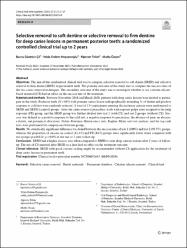Selective removal to soft dentine or selective removal to firm dentine for deep caries lesions in permanent posterior teeth: a randomized controlled clinical trial up to 2 years
Künye
Gözetici Çil, B., Erdem Hepşenoğlu, Y., Tekin, A. ve Özcan, M. (2023). Selective removal to soft dentine or selective removal to firm dentine for deep caries lesions in permanent posterior teeth: a randomized controlled clinical trial up to 2 years. Clinical Oral Investigations, 27(5), 2125-2137. https://dx.doi.org/10.1007/s00784-022-04815-0Özet
ObjectivesThe aim of this randomized clinical trial was to compare selective removal to soft dentin (SRSD) and selective removal to firm dentin (SRFD) in permanent teeth. The primary outcome of the study was to compare the success rates of the two caries removal techniques. The secondary outcome of the study was to investigate whether or not calcium silicate-based material (CS) had an effect on the success rate of the treatment. Materials and methodsBetween November 2018 and March 2020, patients with deep caries lesions were invited to participate in the study. Posterior teeth (N = 165) with primary caries lesion radiographically extending 3/4 of dentin and positive response to cold test were randomly selected. A total of 134 participants meeting the inclusion criteria were randomized to SRSD and SRFD (control) groups. After the caries removal procedure, teeth with exposed pulps were assigned to the pulp exposure (PE) group, and the SRSD group was further divided into test 1 (with CS) and test 2 groups (without CS). Success was defined as a positive response to the cold test, a negative response to percussion, the absence of pain, an abscess, a fistula, and periapical alterations. Fisher-Freeman-Halton exact tests, Kaplan-Meier survival analysis, and the log-rank tests were performed for comparisons between groups. ResultsNo statistically significant difference was found between the success rates of test 1 (100%) and test 2 (93.5%) groups, whereas the proportion of success in control (82.4%) and PE (84%) groups were significantly lower when compared with test groups (p = 0.024; p < 0.05) at the end of 2-year follow-up. ConclusionsSRSD had a higher success rate when compared to SRFD to treat deep carious lesions after 2 years of follow-up. The use of CS material after SRSD as a liner had no effect on the treatment outcome. Trial registrationClinical trial registration number NCT04052685 (08/09/2019).


















